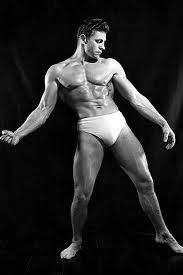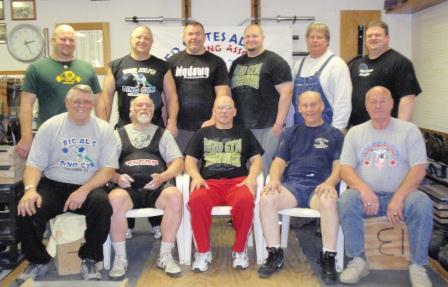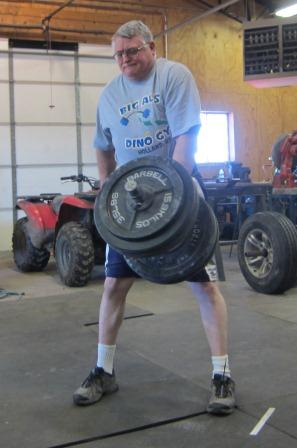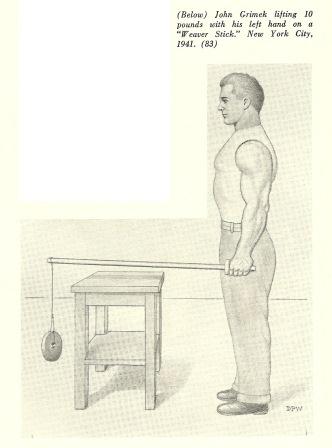by Al Myers
Dino Gym Record Day
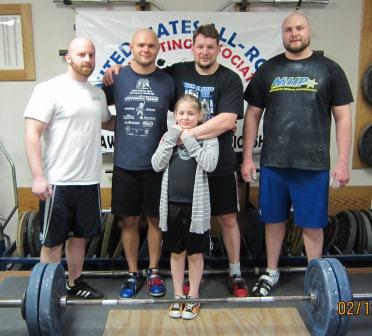
The USAWA welcome Jobes Steel Jungle to their first USAWA event! (front): Gabby Jobe (back row left to right): Troy Goetsch, Corey Kenkel, Jesse Jobe, Bryan Benzel
MEET REPORT
On Sunday the Dino Gym had the most participants in a record day than EVER BEFORE. There was a total of 15 competitors setting new USAWA records! I haven’t done an absolute record count yet, but I won’t be surprised to see it number over 150. There were so many outstanding lifts that it will be impossible to cover everything in this meet report, so I’m going to save some of “the best stories” for individual news stories at a latter date. Plus I am under a time crunch to get this announced today, so the meet report will be short (that’s a FIRST FOR ME!).
First of all I want to thank all the new lifters from the USAWA’s newest club, Jobe’s Steel Jungle, for attending. I really enjoyed watching them set new USAWA records. They were all like “kids in a candy shop” as they got introduced to the many, many lifts of the USAWA. One of them would do a lift and then the rest of them wanted to join in! I also was quite impressed with Jesse’s daughter Gabby. She is only 9 years old but I could tell she was “trained up” to do the lifts she set records in. Jesse’s gym is in Council Bluffs, Iowa. I made the mistake as referring to them as “the Nebraska boys” (which NOT all live in Nebraska) – I won’t do that again!!! I KNOW we will be seeing more of Jobes Steel Jungle in the future.
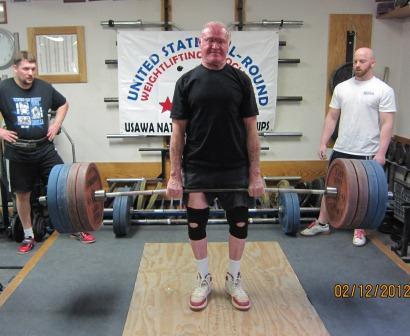
Wilbur Miller deadlifting 457 pounds at the age of 79!
The BIG NEWS of the day was that Wilbur Miller made an appearance – and this time he came ready to lift and set records! Alot of the new lifters didn’t know Wilbur – but after the spectacular lifting he did they know him now! Wilbur lifts like a man half his age. He started off with the squat for record. I told him the USAWA requires a 12″ base (the regular squat is not an USAWA lift), but that didn’t make any difference as Wilburs stance is close to 12″ normally. He finished with an unbelievable 320 pounds!!! (YES – I said that right!). He then went to his favorite lift, the deadlifts, and set some big records in several different variations. I will be covering Wilburs performance at this record day in more detail in future stories.
Dean Ross set the most records. Dean had A PLAN and he executed it perfectly. He had the lifts he wanted to do and he went about setting records in a systematic fashion. I had to take a break when I was imputing his lifts into this meet report because that alone was tiring me out! At this rapid pace Dean is on with record breaking, it won’t be long and he’ll be in the CENTURY CLUB (and may I say faster than anyone else has ever done it!)
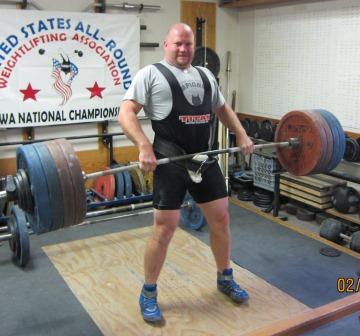
Chad Ullom performing a 480# Continental to Belt, the most ever done in the USAWA.
My dad LaVerne didn’t get enough “grip lifting” the day before at the Grip Champs and came to break some finger lifts. Well, he did records on every finger including his thumb! He was the first one in the gym to do his lifts and I think he did all of them in under 20 minutes! Every record lift he did he had much more in him to do more.
Dino Gym member Chuck Cookson didn’t set alot of records, but the ones he did were HUGE! He broke the ALL TIME records in the French Press with a lift of 207 pounds and in the Bent Arm Pullover with a lift of 195 pounds. I have seen very few people do a French Press in the proper manner as defined in our USAWA Rule Book, but Chuck’s has perfect body mechanics for this lift and performed this big lift of his very strict. His elbows stayed high and the bar touched the back of his neck easily.
I could say so much more, but that’s it for today. I want to thank everyone who showed up to lift in this record day. Participation is what makes a record day a special event. I especially want to thank Mike Murdock and Denny Habecker for taking their time officiating all day, at the expense of doing all the record lifts they wanted to do.
MEET RESULTS
Dino Gym Record Day
Dino Gym, Holland, Kansas
February 12th, 2012
Meet Director: Al Myers
Officials: Al Myers, Denny Habecker, Mike Murdock
Gabby Jobe – Female, 9 years old, 89# BWT
Maxey Press: 38#
Push Press – From Rack: 45#
Hack Lift: 115#
Jefferson Lift: 115#
Deadlift – 12″ Base: 115#
Bryan Benzel – 24 years old, 284# BWT
Holdout – Raised: 71#
Holdout – Lowered: 71#
James Lift: 159#
Clean and Press – Reverse Grip: 259#
Miller Clean and Jerk: 110#
Clean and Jerk – Fulton Bar: 253#
Continental to Chest and Jerk: 298#
Hack Lift: 507#
Saxon Snatch: 95#
Troy Goetsch – 25 years old, 194# BWT
Maxey Press: 183#
Press – From Rack: 185#
Press – From Rack, Behind Neck: 155#
Clean and Press: 192#
Continental to Chest and Jerk: 220#
Deadlift – Heels Together: 429#
Deadlift – 12″ Base: 429#
Deadlift – Civattone Grip: 429#
Deadlift – Reeves: 300#
Bench Press – Hands Together: 250#
Deadlift – Fulton Bar: 506#
Snatch – Fulton Bar: 143#
Continental to Chest – Fulton Bar: 220#
Corey Kenkel – 29 years old, 206# BWT
Maxey Press: 203#
Push Press – From Rack: 185#
Press – From Rack: 185#
Clean and Jerk – Dumbbell, Left Arm: 75#
Jesse Jobe – 35 years old, 225# BWT
Maxey Press – 193#
Push Press – From Rack: 205#
Cyr Press: 125#
Curl – Reverse Grip: 154#
Bent Over Row: 286#
Continental To Belt: 407#
Pinch Grip – Right Hand: 63#
Pinch Grip – Left Hand: 70#
Bench Press – Left Arm: 100#
Bench Press – Right Arm: 110#
Jefferson Lift – Fulton Bar: 385#
Deadlift – Fulton Bar: 451#
Rectangular Fix: 80#
Saxon Snatch: 85#
Scott Tully – 36 years old, 344# BWT
Clean and Jerk – Fulton Bar: 203#
Jefferson Lift – Fulton Bar: 403#
Curl – 2 Dumbbells, Cheat: 170#
Curl – Dumbbell, Cheat, Left Arm: 90#
Curl – Dumbbell, Cheat, Right Arm: 90#
Lateral Raise – Lying: 80#
Turkish Get Up: 40#
Chad Ullom – 40 years old, 248# BWT
Gardner – Half: 110#
Clean and Press – Alternate Grip: 159#
Miller Clean and Jerk: 110#
Squat – Piper: 230#
Continental to Belt: 480#
Chuck Cookson – 42 years old, 286# BWT
French Press: 207#
Pullover – Bent Arm: 195#
Curl – Dumbbell, Cheat, Right Arm: 110#
Curl – Dumbbell, Cheat, Left Arm: 110#
Al Myers – 45 years old, 251# BWT
Pullover – Bent Arm: 145#
Bench Press – Reverse Grip: 310#
Bench Press – Alternate Grip: 310#
Bench Press – Hands Together: 280#
Lateral Raise – Lying: 70#
Mark Mitchell – 51 years old, 360# BWT
Clean and Press – Fulton Bar: 223#
Deadlift – Fulton Bar: 403#
Maxey Press: 272#
Pinch Grip: 252#
Saxon Snatch: 107#
LaVerne Myers – 67 years old, 250# BWT
Finger Lift – Little, Left Hand: 48#
Finger Lift – Little, Right Hand: 48#
Finger Lift – Index, Left Hand: 58#
Finger Lift – Index, Right Hand: 58#
Finger Lift – Ring, Left Hand: 58#
Finger Lift – Ring, Right Hand: 58#
Finger Lift – Middle, Left Hand: 78#
Finger Lift – Middle, Right Hand: 78#
Finger Lift – Thumb, Left Hand: 48#
Finger Lift – Thumb, Right Hand: 38#
Curl – Cheat: 141#
Denny Habecker – 69 years old, 186# BWT
Clean and Press – 2 Dumbbells: 120#
Clean and Press – 2 Dumbbells, Heels Together: 110#
Curl – Dumbbell, Cheat, Left Arm: 50#
Curl – Dumbbell, Cheat, Right Arm: 60#
Swing – Dumbbell, Right Arm: 60#
Dean Ross – 69 years old, 272# BWT
Curl – 2 Dumbbells, Cheat: 80#
Curl – Dumbbell, Cheat, Left: 50#
Curl – Dumbbell, Cheat, Right: 50#
Clean and Press – 2 Dumbbells: 80#
Clean and Press – 2 Dumbbells, Heels Together: 80#
Press – Dumbbell, Right Arm: 55#
Press – Dumbbell, Left Arm: 50#
Snatch – Dumbbell, Right Arm: 60#
Snatch – Dumbbell, Left Arm: 60#
Vertical Bar Deadlift – 1 Bar, 2″, Left Hand: 127#
Vertical Bar Deadlift – 1 Bar, 2″, Right Hand: 127#
Bent Over Row: 179#
Deadlift – Ciavattone Grip: 223#
Pullover and Push: 135#
Curl – Reverse Grip: 104#
Clean and Press – Reverse Grip: 104#
Clean and Press – Alternate Grip: 104#
Clean and Press – 12″ Base: 104#
Clean and Press: 104#
Clean and Push Press: 104#
Two Hands Anyhow: 80#
Deadlift – Trap Bar: 317#
Mike Murdock – 71 years old, 236# BWT
Bench Press – Hands Together: 145#
Bench Press – Left Arm: 55#
Bench Press – Right Arm: 55#
Curl – Dumbbell, Cheat, Right Arm: 55#
Curl – Dumbbell, Cheat, Left Arm: 60#
Wilbur Miller – 79 years old, 218# BWT
Squat – 12″ Base: 320#
Deadlift – Ciavattone Grip: 397#
Deadlift – Heels Together: 419#
Deadlift – 12″ Base: 457#
Jesse Jobe and Corey Kenkel
Team Deadlift – Fulton Bar, Ciavattone Grip: 556#
Bryan Benzel and Troy Goetsch
Team Deadlift – Fulton Bar, Ciavattone Grip: 628#
